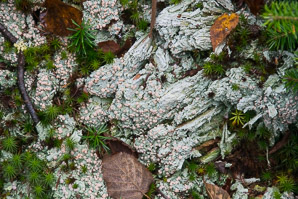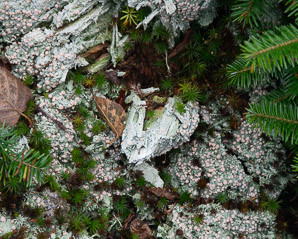
|
Icmadophila ericetorum (L.) Zahlbr.
This moisture-loving lichen is native to Europe and North America, especially in cooler climates, but it is found in arctic habitats and even, occasionally, in rainforests. It grows on peat, rotting logs, humus, turf, clay, dead mosses, in shaded areas. In addition to the common names listed, “fairy puke” is among several that are less charming. Identification: The lichen is crustose, looking a bit like spilled paint, thinly coating its substrate with a greenish-grayish (often described as mint green), granular surface. Fruits: Fruiting bodies, or apothecia, as they are called in lichens, are pinkish, pale orange, or brownish, and 1/32-⅛″ (1.5-4 mm) in diameter. They are rounded, and wrinkled, a bit like brains. They are often in clusters. They look a bit like tiny mushroom caps. They are usually stalkless, but may have short stalks. These are closely similar: |
10/5/2014 · Mt. Killington, Killington, Vermont · ≈ 12 × 8″ (30 × 20 cm) 10/5/2014 · Mt. Killington, Killington, Vermont · ≈ 12 × 8″ (30 × 20 cm) |
||||||||||
|
| |||||||||||
Dibaeis baeomyces |
You are here Icmadophila ericetorum |
||||||||||
|---|---|---|---|---|---|---|---|---|---|---|---|
| Common Name |  |
 |
|||||||||
| Plant | Gray or white, crustose, smooth or with a powdery appearance with rounded or flattened “warts.” The warts are up to 1/32″ (1 mm) in size in sterile plants. In fertile plants, they are less than a third of a millimeter in size. | The lichen is crustose, looking a bit like spilled paint, thinly coating its substrate with a greenish-grayish (often described as mint green), granular surface. | |||||||||
| Fruit | The apothecia, or fruiting bodies, are pale pink, 1/32-⅛″ (1-4 mm) around, on tiny white stalks—they resemble tiny pink mushrooms. The white stalks are usually clearly visible. | Fruiting bodies, or apothecia, as they are called in lichens, are pinkish, pale orange, or brownish, and 1/32-⅛″ (1.5-4 mm) in diameter. They are rounded, and wrinkled, a bit like brains. They are often in clusters. They look a bit like tiny mushroom caps. They are usually stalkless, but may have short stalks. | |||||||||
| Type | Wild | Wild | |||||||||
Online References:
Alan Silverside's Lichen Pages on LastDragon.org
Botanyphoto.botanicalgarden.ubc.ca
Www.centralcoastbiodiversity.org
References:
Icmadophila ericetorum description by Thomas H. Kent, last updated 5 Oct 2021.
© FloraFinder.org. All rights reserved.



